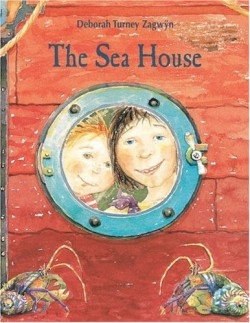
The Sea House
A much-anticipated family visit goes awry for Clee when her beloved uncle turns out to have some unexpected flaws. Uncle “Fishtank” Hal lives happily on a barge, despite the fact that he hasn’t quite mastered the art of tying sailor’s knots. When Clee and her younger brother, Simon, arrive for a visit, she is alarmed by their uncle’s untidy habits and carelessness. She awakens one night to discover that Hal’s mooring knots have untied, and the barge is at sea. Stuck without an engine, the three work together to save themselves, and Clee learns to appreciate her uncle’s positive qualities.
Clee has appeared in three of the author’s previous stories. In each, her adventure is tied to a season, in this case, summer. As in her earlier offerings, Zagw\n uses poetic text and vibrant watercolor to capture the magic of nature and human relationships from a child’s point of view. Children will be intrigued by the knot motif carried throughout the story. Despite his reliance on “me sailor handbook,“ Fishtank Hal knots don’t hold, and the consequences worsen with every failed attempt. Paired with each resulting disaster are small paintings and short descriptions explaining the nautical uses for loop knots, anchor bends, and the like. After a scaffold knot holding up Simon’s hammock comes loose, Clee muses, “Uncle Hal’s knots were full of promises before they let you down.“
Two hermit crabs accompany the family on their adventure, adding further child appeal to the story. The crabs live in a tank “half full and murky,” and Clee looks on as they move about their home, their restlessness mirroring her own. At the end of the book, Clee sets them free in a tidal pool, and has an epiphany as she watches them choose larger dogwinkle shells to inhabit. “Maybe Uncle Hal’s boat was a dogwinkle barge,” Clee thinks. “A strange house, different at first, but once you got used to it, it felt like home.”
Although the author leaves Clee, Hal, and Simon still marooned on a sand bar, the reader is confident that when the tide comes, they will move on, just like the hermit crabs. The story is best suited for primary grade children who can appreciate the imagery and metaphor of Zagw\n’s text.
The expressive illustrations depict summertime at sea with detail that invites closer attention. Libraries owning the other three Clee books will definitely want to purchase this offering. The seaside setting and maritime theme will make this a popular selection for summer reading.
Disclosure: This article is not an endorsement, but a review. The publisher of this book provided free copies of the book to have their book reviewed by a professional reviewer. No fee was paid by the publisher for this review. Foreword Reviews only recommends books that we love. Foreword Magazine, Inc. is disclosing this in accordance with the Federal Trade Commission’s 16 CFR, Part 255.
